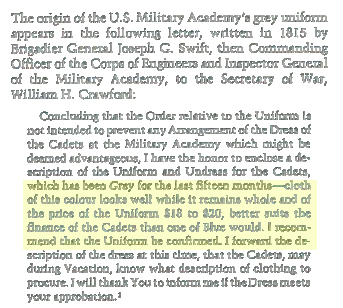 15 November 1815 letter,
source below:
15 November 1815 letter,
source below:
West Point Lore
Because, due to the British blockade of indigo dye from India during the War of 1812, gray uniforms were cheaper, not because General Winfield Scott’s soldiers had also worn them (because they were cheaper).
Not
because of the Battle of Chippawa (sometimes incorrectly spelled "Chippewa"), but because gray cloth for the cadet uniforms was
cheaper!
Per 1815 letter, discovered in the National Archives, from the Academy to the War
Department recommending gray uniforms. See articles below:
U.S.M.A.
Corps of Cadets, The Military Images, Sep/Oct 2000 by McAfee, Michael J.
(RIP - 2019, Curator, West Point Museum)
 15 November 1815 letter,
source below:
15 November 1815 letter,
source below:
with authors
H. Charles
McBarron, Jr, “Dean of American Military Historians and Military Illustrators,”
and Detmar H. Finke, who authored numerous military history articles and books
and was Chief of the General Reference Branch, Company of Military Historians (www.military-historians.org).
The West Point Museum: A Guide to the
Collections by Richard E. Kuehne and Michael J. McAfee, 1987
Kuehne was the Director of the West Point Museum, McAfee, History Curator
Gray Matter by J. Phoenix, Esq
Past in Review (West Point Magazine, Spring 2013): Cadet Gray
Also BTW, Mr. McAfee wrote us on 1/4/2012: “Have you heard the Army's reason why dress blue trousers are lighter than the coats? The Army version is that out in the West the soldiers did not wear their coats as it was too hot, so as a result the pants faded to a lighter shade. Again, pants wore out more quickly since they were worn in fatigue as well as dress uniforms, so the pants were made of CHEAPER cloth. First in gray then in the 1830s with light or sky blue kersey cloth. The only thing that faded was the tape trim on uniforms in the 19th century (eventually prompting a short return to white rather than light blue for infantry and a yellow-orange rather than lemon yellow for cavalry trim).”
Also BTW, Mr. McAfee wrote on 1/18/2012:
"Winfield Scott wrote (c.1864) in his autobiography that the cadets wore gray because of his victory at the 5 July 1814 Battle of Chippawa. That is the only contemporaneous claim that I have ever seen for such an explanation. This seems to have been picked up and repeated through the rest of the century." -- Supporting quote from "Memoirs of Lieut.-General Scott, LL.D." Written by Himself. Books for Libraries Press, Freeport, NY, first published 1864, reprinted 1970, p. 128-9: "When Scott was seen approaching the bridge, General Riall, who had dispersed twice his numbers the winter before, in his expedition on the American side, said: 'It is nothing but a body of Buffalo militia!' But when the bridge was passed in fine style, under his heavy fire of artillery, he added with an oath: 'Why, these are regulars!' The gray coats at first deceived him, which Scott was obliged to accept, there being no blue cloth in the country. (In compliment to the battle of Chippewa, our military cadets have worn gray coats ever since.) Two hostile lines were now in view of each other, but a little beyond the effective range of musketry."
Here is an instance of General Scott pushing his version of events. See pages 17-19.
"Fred's [Todd's] book ["Cadet Gray," which perpetuates Scott's claim] was written before later research in the National Archives uncovered the official correspondence relating to the 1816 decision to stay with gray cloth for cadet uniforms. The history of pre-1816, and even later, cadet uniforms is clouded by a lack of contemporary graphics. All illustrations are reconstructions based on descriptions and known examples of contemporary non-cadet uniforms, so the EXACT nature of cadet uniforms prior to photography is not fully known.
"For example, in Fred's book, "Cadet Gray," [p. opp 25] the Partridge gray uniform still exists (Norwich University) and is the basis of the cadet uniform also shown, BUT the style cap worn with the cap plate and shown in the drawing is supposition. That is the enlisted pattern leather cap adopted c. 1813, but there was an earlier leather cap in the "yeoman" style which could also have been worn. There is no description of the cap worn with the War of 1812 gray uniform. In 1816, they reverted to the wool felt 'round' hat worn prior to the 1812 era leather cap."
Also addressing the "truly legend and not fact" Scott association: West Point's 1991 "Assembly," Vol 50, page 37:
“More to the Point” by Colonel George Pappas [founder, US Army Heritage and Education Center], Assembly, November 1991, p 37: “ … Of general interest is the adoption of the gray uniform for the Corps. It has become legend that this uniform was prescribed after the War of 1812 to honor Winfield Scott for his action at the Battle of Chippewa. This is truly legend and not fact. The Corps was first clothed in gray uniforms for the same reason that Scott's troops wore gray instead of blue: wartime shortages and inflated costs made it impossible to obtain the regulation blue uniforms. After the war, Superintendent Joseph Swift found that blue uniform cloth was still much more expensive than gray woolen material, so much so that he recommended to the Secretary of War that gray be used to reduce cadet uniform costs. Secretary William Crawford approved Swift's recommendation and the Corps continued to wear gray. How did the legend originate? The earliest reference I have found is in Scott's memoirs published in 1864. Boyton does cite an 1816 date for adoption of the gray uniform but makes no mention of honoring Scott. Fred Todd, then Director of the USMA Museum, cited the full Scott legend in his Cadet Gray, published in 1955. Swift's letter to the Secretary of War negates these claims. It thus can be stated as a documented fact that the gray uniform was adopted permanently in 1816 solely as an economic measure.”
More from Colonel Pappas
in To the Point: The United States Military Academy, 1802-1902,
copyright 1993. p. 71-72:
"The prescribed uniform for cadets was a dark blue coat with gray trousers in
summer and dark blue in winter. Wartime restrictions made it difficult to
obtain good, blue-wool cloth. [Indigo dye -- the color between blue and
violet -- typically came from India, though some was produced in South Carolina. During the War of 1812, the British
blockade played havoc with American shipping, further reducing supplies of the
dye already depleted by President Jefferson's 1807-9 selective foreign trade
embargo. With troop recruitment ramping up,] many units, including Winfield
Scott's brigade, were issued gray uniforms [instead of blue]. For the same reason, cadets
were given gray uniforms in late summer 1814. In September 1816, [first
West Point graduate General Joseph] Swift recommended that the gray uniform be
retained as the permanent uniform, indicating that 'the price of the uniform
$18-$20 better suits the finance of the Cadets than one of Blue would.' He
added, 'the Uniform and Undress for Cadets...has been Grey for the last fifteen
months.' Many years later, Scott claimed in his memoirs that the gray
uniform was adopted to commemorate his victory over the British at the Battle of
Chippewa. Such was not the reason for the permanent change from blue to
gray; the main factor was cost. Cadets were not the only gray-clad figures
at West Point. Captain Partridge wore a gray coatee with three rows of
buttons despite the regulation for Engineer officers to wear blue. The
1816 cadet uniform coat may have been patterned after Partridge's coatee.
Partridge's nickname, 'Old Pewter,' may have come from his gray uniform."
Also of interest: "Long Gray Line Uniform Factory Lesson": http://www.youtube.com/watch?v=LlKRAOUGeyg and Battle of Chippawa: http://en.wikipedia.org/wiki/Battle_of_Chippawa
Also: http://www.westpointaog.org/page.aspx?pid=3654&chid=184 and Superintendent Alden Partridge: http://en.wikipedia.org/wiki/Alden_Partridge
http://www.westpointaog.org/document.doc?id=4969 (mentions Partridge as "Old Pewter" wearing a gray uniform before his cadets did).
and http://www.jcs-group.com/military/land-based/west.html
"Cadet Uniforms" courtesy USMA AOG 2000, West Point 2001 Bicentennial Calendar: "Four years later [1814], the familiar gray full dress coat appeared -- because blue woolen cloth was too expensive."
Here is an article posted on a bulletin introducing a story on www.TheDaysForward.com
"Cadets attending the United States Military Academy (USMA) have long been recognized by the gray uniforms they wear. Founded in 1802 during the presidency of Thomas Jefferson, USMA did not have these signature uniforms until some years later. In November 1815, Brigadier General J.G. Swift, the Academy Inspector (and the first graduate of the Military Academy in 1802), sent the following message to the Secretary of the Army, “I have the honor to enclose a description of the Uniform and undress [uniform for marches, drills, fatigue duty, and ordinary wear] for the Cadets which has been grey for the last fifteen months – cloth of this colour looks military…as the price of this Uniform, $18 to $20, better suits the finances of Cadets than one of Blue would --- I recommend that the uniform be confirmed.” This recommendation was accepted in September 1816 and the gray uniforms were born. While Captain Alden Partridge (Class of 1806) was the Acting Superintendent (1814-1817), the gray wool uniform with “three rows of gold gilt bullet buttons in the front” [likely based upon Partridge's uniform, page 72] became the pattern for today’s uniform. West Point’s Cadet Uniform Factory (CUF) came into existence by an act of Congress in 1878. Since then, the CUF has been responsible for cutting the wool cloth raised in the Western U.S., sewing it, and later, altering and repairing the uniforms for the entire Corps of Cadets." http://wb32.r.ca.d.sendibm2.com/12tb33fqvnf.html
Note: The 28 November 1815 letter [see above clipping] from General Swift mentions that 15 months earlier the cadets were wearing gray uniforms for cost-effectiveness. This would put their wearing them into August 1814. The Battle of Chippawa* on 5 July 1814, would seem to have been too soon before the cadets started to wear gray uniforms, word and appreciation having to have spread quickly in those days of slow travel; and subsequent procurement and sewing of cloth from New York City also a time-consuming effort.
Information on earliest known gray uniform (courtesy of Michael J. McAfee): Portrait of John Courts Jones, Jr. (circa 1816) and accompanying story. BTW, Mr. Jones (class of 1819), having been appointed at-large from Georgia, did not graduate. His father apparently was a veteran of the Revolutionary War, with the family home in Maryland.
* Note: It's possible that the incorrect spelling of the Ontario, Canada, town of Chippawa as "Chippewa" by the American Army in its histories and posters also came from General Winfield Scott. Here is a photo of a German-language "Glorious News" article printed in Easton, PA, relating to "Chippewa" and General Scott:
And tradition has kept the uniforms gray.
Bottom line: In 1817, Captain Alden Partridge, West Point's acting superintendent
beginning in 1814, was
not confirmed or promoted but replaced as West Point Superintendent by Sylvanus Thayer
in 1817.
Partridge subsequently resigned his military commission in 1818 and founded the military
academy (now Norwich University) in Northfield, Vermont, in 1819.
Partridge died in 1854, ten years before former Commanding General of the Army
Winfield Scott wrote his autobiography colorfully claiming his victory at
"Chippewa" put the gray into West Point. Despite the fact that (dare it be
said, the likely self-promoting or at least wishful-thinking) war-hero General Scott
loved West Point and is buried in its cemetery, hopefully Partridge's outranked
and out-promoted full truth (it was cheaper) will out!
Note: The term "legend"
applies to a "non-historical or unverifiable story handed down by tradition from
earlier times and popularly accepted as historical." By this common
definition, the Winfield Scott version of West Point's gray uniforms is not
"legend," and, given the numerous disputes aired in the past, it is certainly
not "tradition." Indeed, it is way more illusory, romantic
fictional entertainment than
education! At the worst and at this point, one could even say it's
disinformation!
Note: Here is one of the instances of General Scott passing along his
version of events; see pages 17-19):
https://archive.org/stream/cu31924032282018/cu31924032282018_djvu.txt
Please pass this on to romantically-inclined authors looking to put cheap color into West Point's well-earned and well-worn gray. Thanks!
N.B. The West Point cadet full-dress uniform (gray wool with black piping and gold buttons/rank stripes) was set before the very fortunate but coincidental black, gray, and gold gunpowder symbolism was realized. Black, gray, and gold are West Point's school colors, representing the components of gunpowder: black charcoal, gray saltpeter, and gold sulfur. Charcoal and sulfur act as fuels, saltpeter as an oxidizer. Charcoal is wood burned in a low-oxygen environment to produce a more pure form of carbon. Sulfur [aka brimstone or burning stone] is a mineral with a low burning temperature, acting essentially as kindling. Saltpeter [potassium nitrate] acts as an oxidizer and so aids in combustion.
N.B. Please feel free to pass
this information along to the USMA powers-that-be at
https://www.westpoint.edu/about/public-affairs/news/fact-sheets ("West
Point Cadet Uniforms") I have notified them in the past but no response and
no change.
In the summer of 1814, a small American
Army, led by General Winfield Scott wearing gray, decisively defeated the
British in upper Canada . Gray uniforms at once became badges of honor and the
Academy decided to utilize the color gray in memory of Scott's victory. In 1816,
the Secretary of War formally approved the use of gray uniforms for the Military
Academy in recognition of General Scott and his gallant troops. There are few
uniforms the world over so renowned as "cadet gray."
Little help? If you’re a Quora user, your help would be much
appreciated. I’m trying to beat back some misinformation that’s becoming more
prevalent by the day. Hopefully, you’ll upvote this answer
derived from research from a former West Point museum curator, not the myth
propagated by Winfield Scott’s self-promoting, erroneous claim.
Original post which includes supporters of misinformation whose posts I’m trying to outdo:
https://www.quora.com/Why-are-West-Point-uniforms-gray
Thanks!
==============================
MacArthur
Speech
Stewart Bornhoft's
usma1969-4um 4/7/2012 reference and response to
LTG Ellis' remembrance
"Gentlemen – I don’t know
if MacArthur was on the poop deck that May day, but I can tell you for certain
who was. Her name is Patricia Riedel. She was the Superintendent’s Secretary
and had been on the job for only a couple years at the time. I met Ms. Riedel
in 1978 shortly before I was selected to be the Aide-de-Camp to the
Superintendent, General Andrew Goodpaster. During two of the most delightful
years of my 26+ on active duty, she and I shared the office that provided
entrance to the Supe’s. She’d been on the job for 20 years by then and had a
wealth of stories.
"Pat told me that MG
Westmoreland, the Supe in 1962, realized (like the cadet who taped the immortal
speech) that General MacArthur might not have a written text, so he stationed
his Secretary on the poop deck (out of sight of course) to take diction. She
told me that the pace of his delivery made taking it down easy enough, but what
made it difficult was reading her shorthand afterwards. Her writing had been
blurred by the tears she shed listening to his address.
"The other story relating to the speech was told to me by Fred Pope, ’64, who witnessed the event. Fred was also on the Supe’s staff when I was there, ’79-81. Fred was a yearling at the time the speech was given. He said that most of the cadets did not realize when they went to the noon meal that day in May 1962 that they were in for an extended stay. (I believe that the Thayer Award is now presented during an evening meal in midweek, but then it was the last thing before weekend privileges began.) As such, back then, the cadets had no way of getting word to their drags who awaited them about what was causing the delay. However, Fred said that it didn’t take long for the angst to give way to excitement as the cadets realized with each sentence of MacArthur’s message that they were witnessing history."
-------------------
The "fall-out" (no pun intended) of Stewart
Bornhoft's forum comment was the subsequent interview article West Point
Magazine did, as well as the very interesting YouTube posting:
Text of the AOG West Point Magazine Pat Riedel interview about MacArthur's
Speech:
https://issuu.com/westpointaog/docs/west_point_magazine_fall_2012/48
Video of the AOG Pat Riedel interview about MacArthur's
Speech:
https://www.youtube.com/watch?v=8Hf9nFXApAQ
4/7/2020: Another item from Stewart's days as the aide to General Andrew Goodpaster, 51st Superintendent of the United States Military Academy at West Point: Did you know that General Goodpaster was an Engineer? Told me the story of how that came about. One day, back when he was a BG [Brigadier General], he got a call from DA DCSPER’s [Army personnel] office. They told him they wanted to convert him from Engineer to Infantry. He asked why it mattered. They said we just need to do it. He acquiesced. Shortly afterwards, he came out on the 2-star list and they wanted to assign him command of the 8th ID [Infantry Division]… so he needed to be an Infantryman to command an Infantry Division. OK, fair enough. Then, they said that he needed to go to jump school because one of the 8th’s brigades was Airborne and they didn’t want the Division CG [Commanding General] to be a leg. So at age 42, newly-minted MG [Major General] Goodpaster reported to Ft. Benning [Airborne School]. Gotta wonder how many NCOs [Non-Commissioned Officers] had the temerity to have Andy drop for ten [push-ups]?
5/4/2020: Another item from Stewart's days as the aide to General Andrew Goodpaster, 51st Superintendent of the United States Military Academy at West Point: The Superintendent’s House (Qtrs 100) is indeed the oldest building on post, built in 1820 when Sylvanus was Supt. One hundred years later, when MacArthur was Supt, he learned of the plans of the Quartermaster Corps. That heartless organization managed property for the Army before such responsibility was given to the Corps of Engineers. (Apologies to my QM friends.) With little regard for the history of Qtrs 100 (or the ghost who resides in its basement … a story for another time), the Post QM intended to raze the building because of its age. No amount of pleading by Doug to the QM powers-that-be could deter them from their plan to demolish (and no doubt replace) his home. Appeals to the highest military authorities in WDC fell on deaf ears. So, Doug wrote a letter. Noting that Robert E. Lee had been the Superintendent at WP from 1852-1855, MacArthur sent his appeal to the Virginia Delegation of the US Congress, explaining that the QM Corps was planning to demolish the home of their beloved Robert E. Lee at West Point. Needless to say, the plans were promptly scratched. Epilogue: Honestly don’t recall when or where I first heard this tale, but I’ve told it so often (usually escorting the Supt’s guests from the reviewing stands to the tailgate prior to FB games), that I’ve come to believe it as gospel. Such is the stuff of legends.
Which Constitution Island?
Ft. Constitution was erected in 1775 on what is now Constitution Island (opposite West Point, across the Hudson River, on which the far end of the Chain was anchored) as a result of hostilities with England. It was named after the unwritten British constitution, as America's Constitution did not yet exist. Information about the Chain: https://en.wikipedia.org/wiki/Hudson_River_Chains
West Point is What?
11/6/2013 - 2/27/2014
Some of you may have read or heard that George Washington said that West Point is the "Key to America." I looked long, hard, and unsuccessfully for a solid reference for that quote which frequently appears in the literature and on numerous historical websites. It turns out that a query to the Mount Vernon Ladies' Association finally solved my problem. Mary V. Thompson, Research Historian, quickly informed me that the "Key to America" is actually a misquote. Washington really said that West Point was the "Key of America" ("Sentiments on a Peace Establishment," 2 May 1783):
"The Regiment of Artillery, with the Artificers, will furnish all the Posts in which Artillery is placed, in proportionate numbers to the Strength and importance of them. The residue, with the Corps of Invalids, will furnish Guards for the Magazines, and Garrison West Point. The importance of this last mentioned Post, is so great, as justly to have been considered, the key of America; It has been so preeminently advantageous to the defence of the United States, and is still so necessary in that view, as well as for the preservation of the Union, that the loss of it might be productive of the most ruinous Consequences. A Naval superiority at Sea and on Lake Champlain, connected by a Chain of Posts on the Hudson River, would effect an entire separation of the States on each side, and render it difficult, if not impracticable for them to co-operate."
Ref: http://memory.loc.gov/cgi-bin/query/r?ammem/mgw:@field%28DOCID+@lit%28gw260425%29%29 and http://www.history.army.mil/books/RevWar/ss/peacedoc.htm
BTW, Mike McAfee of West Point, mentioned previously above, helped me earlier discover that "The Key to America" phrase could be traced to Henry Knox's 17 April 1783 letter to George Washington: https://founders.archives.gov/documents/Washington/99-01-02-11092 and http://www.pbs.org/georgewashington/collection/war_1783apr17.html So, in my take of it, it's quite possible that various authors misattributing Knox's quote was the "key to the confusion"! : )
Moving on to another appellation, is West Point the "Key to the Continent," and did George Washington say so? Despite tempting but unverifiable references (eg, supposedly somewhere in "The Life of George Washington" by Washington Irving), I have not been able to find such a quote either by George Washington or any other historic person in early America. I did find a Watertown 6 January 1776 letter from John Adams to George Washington saying that the Hudson River "...a kind of key to the whole continent...."
Adams quote paraphrased: Ref: "Life of George Washington" by Washington Irving, Vol 2: Found on different pages in different editions. Search for "continent."
https://archive.org/details/lifegeorgewashi01irvigoog
Revolutionary War General
Jedediah
Huntington in a 16 April 1783 letter to George Washington
gave West Point the following moniker: "the key to the United States."
http://rotunda.upress.virginia.edu/founders/default.xqy?keys=FOEA-print-01-02-02-5079
General Henry ("Light
Horse") Lee in his memoirs (page 87) called West Point "the American
Thermopylae":
http://books.google.com/books?id=ukoSAAAAYAAJ&pg=PA87&lpg=PA87&dq=Henry+Lee+West+Point+American+Thermopylae&source=bl&ots=w52XPuMEZS&sig=FGkITLw71qP1gxLk2f9xKdKFpXo&hl=en&sa=X&ei=epIPU5_DMKbU2AXbxYDgAw&ved=0CCoQ6AEwAQ#v=onepage&q=Henry%20Lee%20West%20Point%20American%20Thermopylae&f=false
"The Hudson River" Valley is "Key to the Northern Country" (in so many
words by George Washington):
http://www.loc.gov/teachers/classroommaterials/presentationsandactivities/presentations/timeline/amrev/north/posts.html
However, anyone finding a verifiable
quote by George Washington about West Point being the "Key to America" or the "Key to the Continent,"
please click here and let me know.
Thanks!
BTW, in a 21 March 1781 letter George Washington wrote to William Heath, he called the fortified site of West Point "the most important post in America."
In 1790 Stephen Moore, who owned West Point land, sold it to the government In 1794 George Washington established the artillery's school at West Point.
More about West Point:
http://www.westpointaog.org/WestPointHistory
and West Point in the Making
of America":
http://americanhistory.si.edu/westpoint/history_1.html
and West Point Trivia:
www.west-point.org/family/bicent/trivia.html
and
List of Superintendents: http://military.wikia.com/wiki/Superintendent_of_the_United_States_Military_Academy
Jonathan Williams, grand nephew of Benjamin Franklin and first USMA Superintendent: http://penelope.uchicago.edu/Thayer/E/Journals/WMQ/3d_ser/2/3/US_Military_Philosophical_Society*.html
Maps of West Point: Magnifying capability: https://www.flickr.com/photos/62089238@N00/471354482 Artistic rendition: http://westpointadmissions.com/map.php
F
rom my research, you may be pleased to discover West Point placed the barracks in “correct” geographical order:John J. Pershing, born in Laclede, MO: 39.47 degrees North
Ulysses S. Grant, born in Point Pleasant, OH: 38.89 North
Robert E. Lee, born in Stratford, VA: 38.127 North
Also works for birth and death dates…as to who went south first! : ) QED: Intuitively obvious to the casual grad?? : )
====================================================================================================
From the Spring 2021 edition of West Point magazine
(download):
"From Washington to Palmer: The Story of 'Leaders of Character"
On-line page-turner version:
https://issuu.com/westpointaog/docs/west_point_magazine_spring_2021/52
Video of the article: https://youtu.be/NJsswfI4SVU?si=7Du_vgIa06myrVi5
Special thanks to COL. Mindy Kimball, USMA '96,
Academy Professor in Geography and
Environmental Engineering, who provided
valued information for the article, most importantly that the engraved capstones
on the wall are
made
of pink granite [likely the same type as used in the Battle Monument at Trophy
point]. More fascinating information that she provided:
On the portrait [of LTG Dave R. Palmer] – I found it in the Mess Hall. It’s hung in the wing that normally seats 2nd Regiment Cadets. The windows on that wall face Bradley Barracks and Central Area [near the center of the building]. I snapped a couple of pictures of it so you can see how they have it featured.


Q: What's West Point made of? A The short answer to your question is definitely gneiss. There are some large sections of granite in the area around West Point – namely Storm King Mountain and also Bear Mountain, but almost all of the rocks on West Point itself are closer to gneiss. I love talking about the gneiss because I get to tell Cadets “It’s gneiss, don’t take it for granite!” And it is also very special to know that the gneiss is over 1 billion years old, and has been metamorphosed in the mountain-building events that shaped the Appalachian Mountains, as well as carved and scraped by the glaciers 10,000 years ago!
It's actually gneiss that they use more often, sometimes
construction people call it a "granitic gneiss" - but in Davis barracks they
used a different quarry and it's closer to granite.
I've heard that the quarry used for the gneiss on most buildings
(Mac/Ike/Bradley, etc.) came from a quarry in Connecticut, but I'm not sure how
to confirm.
Yellow dot shows likely location of LTG Palmer's portrait.


More fascinating information provided by COL Kimball to come. Thanks! "West Point is gneiss (pronounced 'nice')!"
Photos below graciously provided by Mrs. Betsy Gilland (USMA '90), wife of USMA Superintendent Steven W. Gilland (USMA '90): "Sir, Here are a couple pics for you. The brick was easily located behind the sentry box in the southwest corner of the gardens. GO ARMY!! Betsy"
NB: LTG Palmer had earlier mentioned the Palmer brick
(manufactured by the Palmer Pressed Brick Company of Palmer, TX).
Sign on sentry box says: "Senty Box — Used by Cadets at Fort Clinton
— Summer Encampments — 1874-1942"
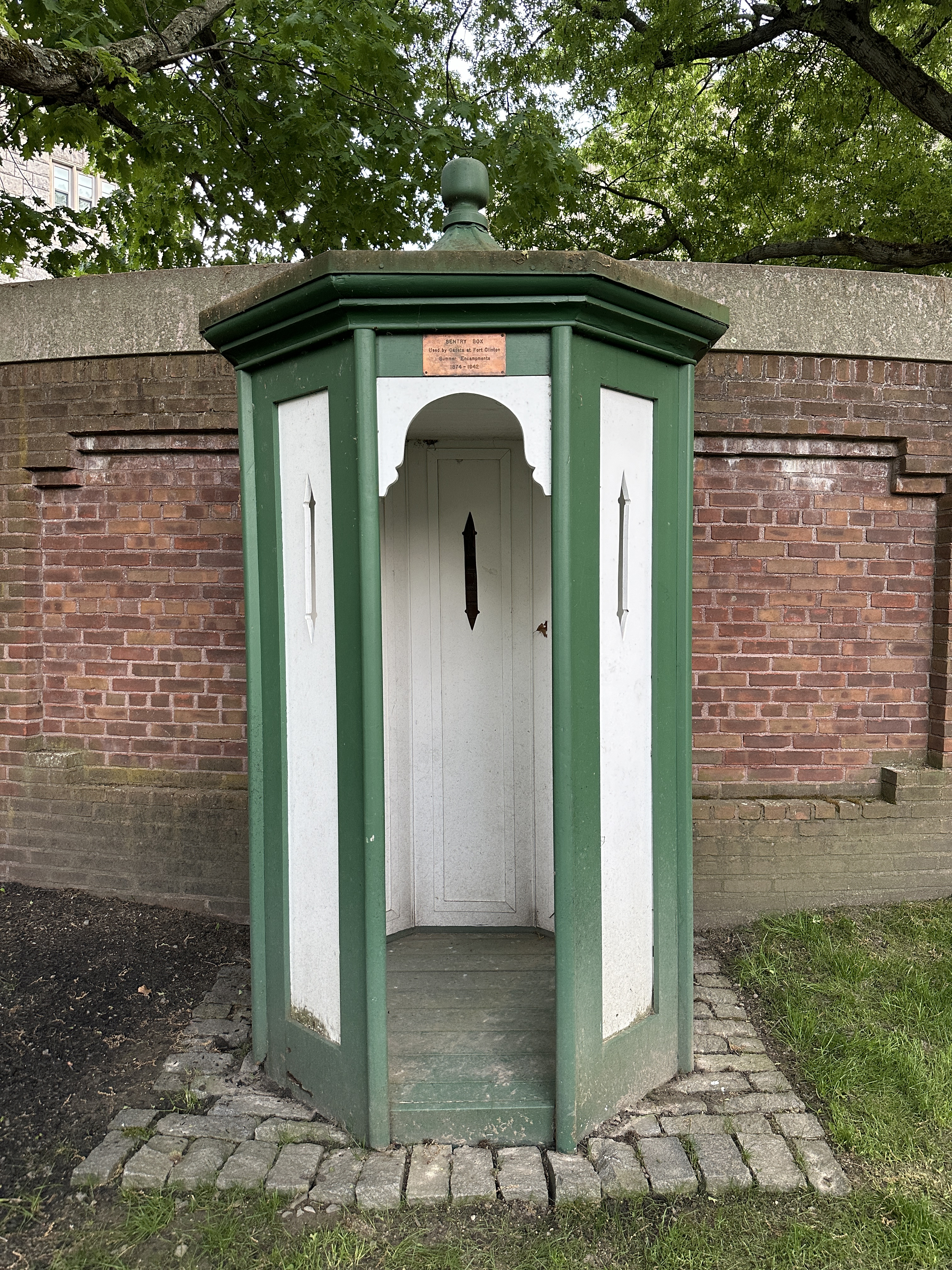
Additional information follows from Jennifer Voigtschild
‘93, USMA Command Historian: Brick is at the back left corner [looking from the
street in front of the Supe's house] of the inside wall of the
garden.
A cadet’s parents, owners of the Palmer Brick Company, Palmer, TX, made
the brick and presented it to LTG Palmer. Since it was of the same type and size of the bricks
procured to
make the new garden wall, the workers put the Palmer Brick where it
could easily be found. As a West Point Museum volunteer, Ms.
Voigtschild produced the following FaceBook item:
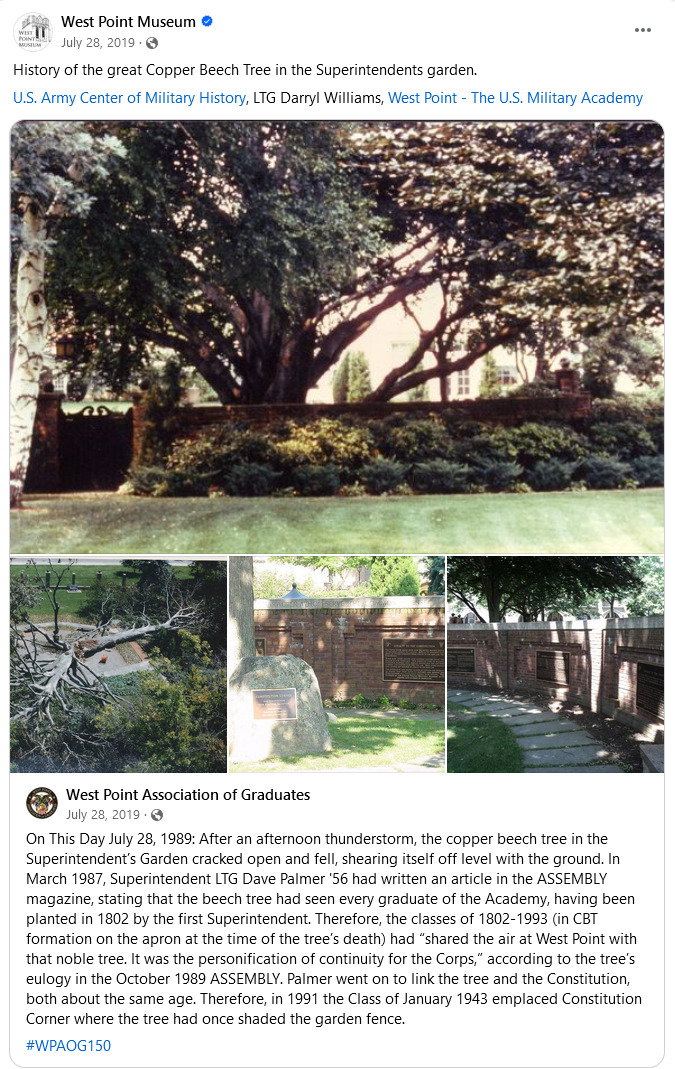
As regards the fallen copper beech tree, Ms. Voigtschild recalled that her Class' unofficial Class Motto is “We Killed the Tree ’93.” : )
The following article from the October 1993 issue of Assembly Magazine is courtesy of Stephanie Erickson, USMA '93.
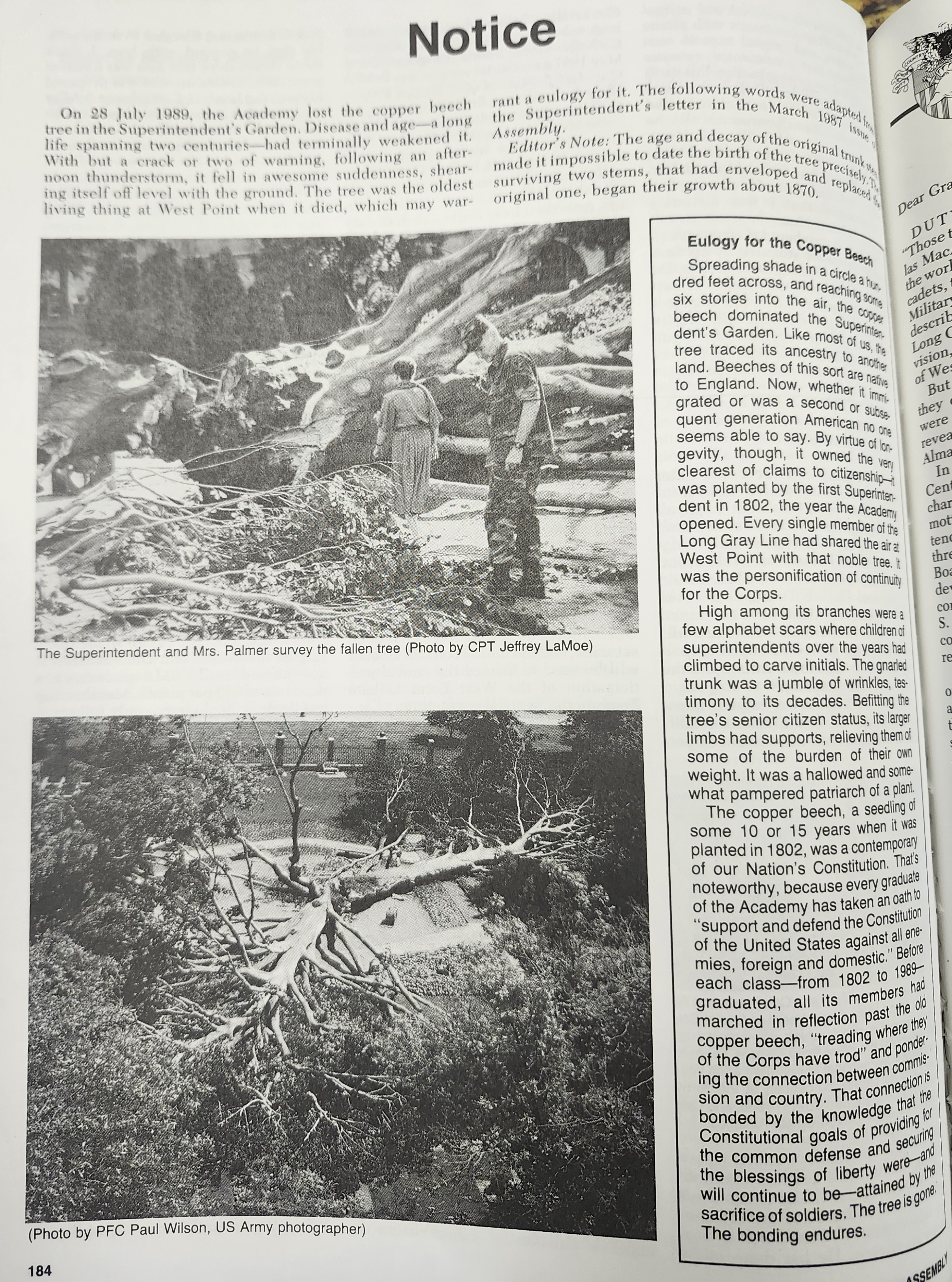
The version below courtesy of Laura Mosher, USMA Library:
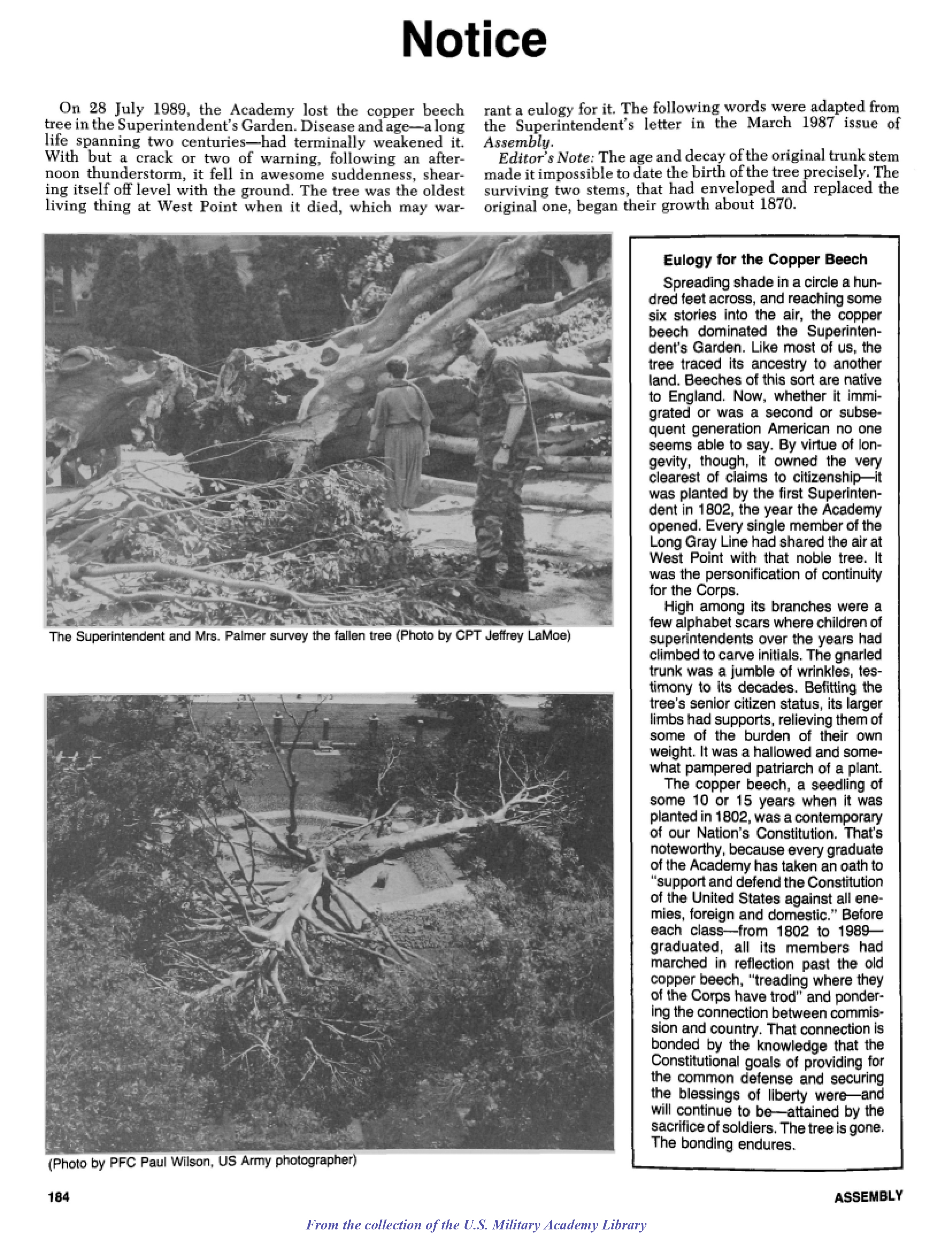

Constitution Corner, 21 May 2024.
======================
George Washington (apparently his next to last letter
[last being about his farms to his farm manager from Scotland, James Anderson]
before his
death) and Alexander Hamilton's correspondence on establishing the US Military
Academy:
Hamilton to Sec War James McHenry: 23 Nov 1799
Hamilton to Washington 28 Nov 1799
Washington to Hamilton 12 Dec 1799
====================================================================================================
Excellent short introduction video about West Point:
https://www.youtube.com/watch?v=WYoB4_jZCIs
Civil War: 294 graduates served on the Union side; 154, Confederate.
Nearly 500 grads died during WWII. 333 West Point graduates died in
Vietnam [30 from the Class of 1966].



West Point is the "Key of America." --
George Washington
"Sentiments on a Peace Establishment," 2 May 1783.
"Glory follows
virtue as if it were its shadow." -- Cicero
"Tusculanarum Disputationum," I. 45, ~ 45 BC
For entrée to many Revolutionary War links, check out www.2va.org





Return to www.bahrnoproducts.com/veteransinfo.htm (see Military Academy section)
"No punishment, in my opinion, is too great for the man who
can 'build his greatness upon his country's ruin.'" — George Washington
"Arbitrary power [tyranny, dictatorship] is most easily established on the
ruins of liberty abused to licentiousness [lawlessness,
irresponsibility, anarchy]." — George Washington
![]()

![]() Strategic Advantage:
Strategic Advantage:
![]()
How to Win in War,
Business, and Life
![]()
![]()
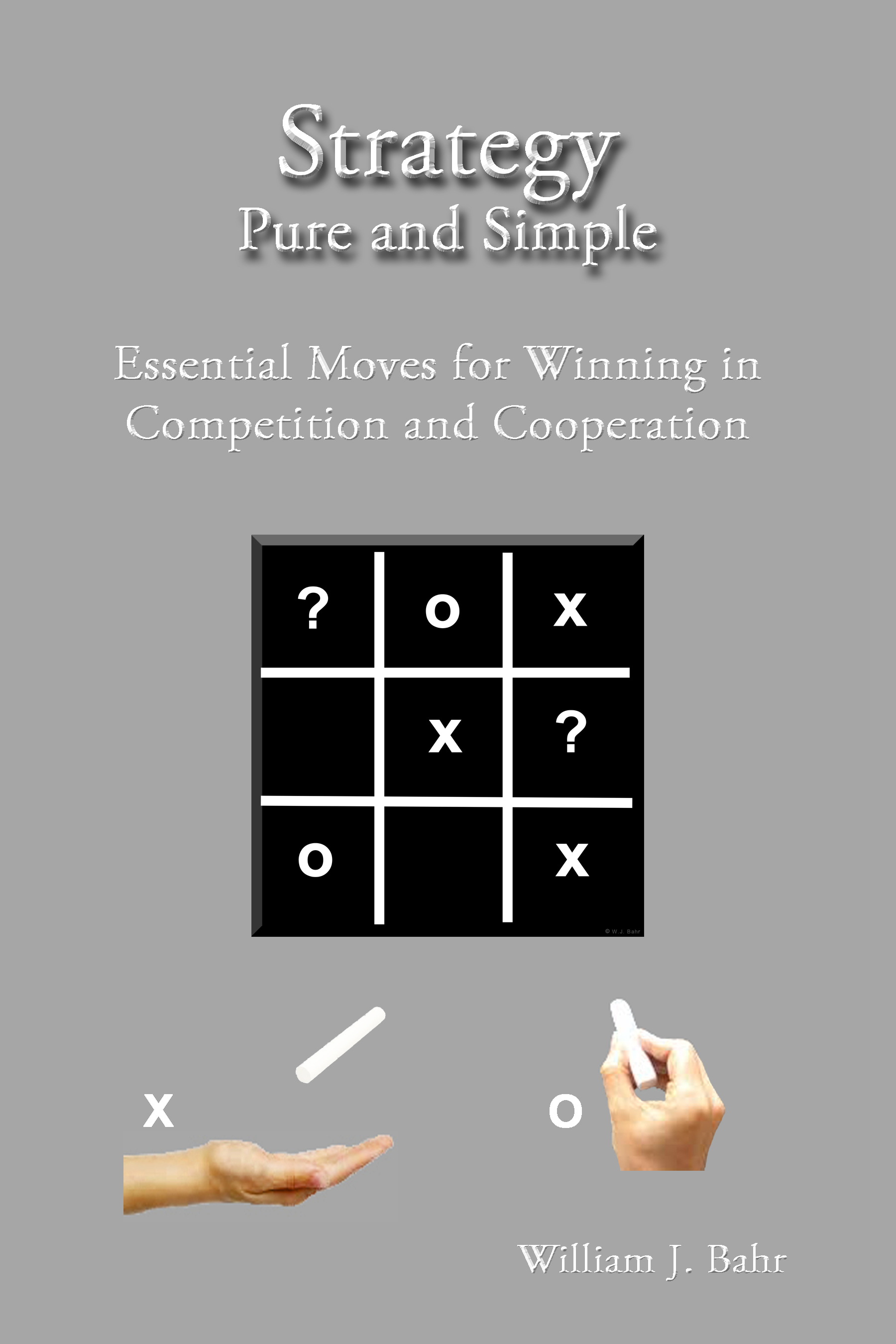
![]() Strategy Pure and Simple:
Strategy Pure and Simple:
![]()
Essential Moves for Winning in
Competition and Cooperation
![]()
![]()
Copyright W. Bahr 2025